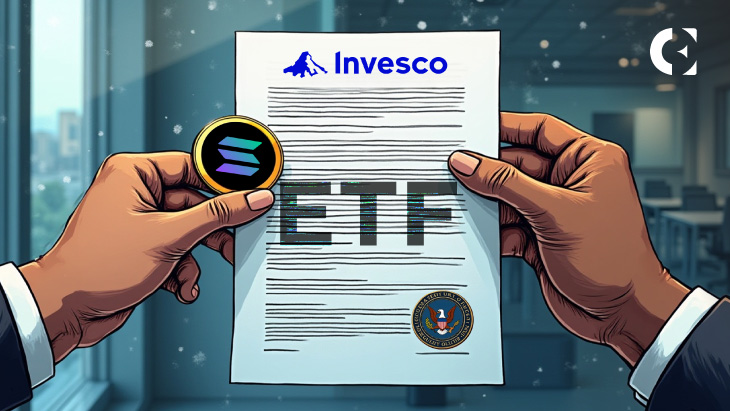- Paul Atkins-led SEC formally acknowledges Invesco Galaxy Solana ETF application.
- Eight issuers now await approval, with analysts predicting October decisions.
- The commodity versus security classification debate continues to affect the approval timeline.
The Securities and Exchange Commission has formally acknowledged receipt of the Invesco Galaxy Spot Solana ETF filing. The agency confirmed it is reviewing the application following Cboe BZX Exchange’s submission of Form 19b-4 proposing rule changes for listing and trading the ETF.
This recognition moves the Invesco file closer to a possible approval decision and starts the SEC’s official review process. The development reflects the SEC’s increasingly accommodating stance toward cryptocurrency products following Atkins’ appointment and the shift in leadership.
Multiple Issuers Queue for Solana ETF Approval
Invesco’s application is one of several large issuers’ pending SEC rulings, which include VanEck, 21Shares, Bitwise, Grayscale, Canary Capital, Franklin Templeton, and Fidelity. The expanding application backlog indicates strong institutional interest in providing Solana exposure through conventional investment vehicles.
The May “immediately effective” application for the REX Shares SOL ETF paved the way, and the fund has since debuted, launching successfully on July 2. This precedent provides optimism for other pending applications as the regulatory pathway becomes clearer.
Industry analysts maintain optimistic outlooks for approval by October, citing the Trump administration’s supportive cryptocurrency stance and the existence of CME-listed Solana futures contracts. These futures products strengthen arguments for spot ETF approval by providing regulated market infrastructure.
Classification Uncertainty Creates Approval Challenges
The licensing procedure is, nevertheless, made more difficult by the continuous dispute about whether Solana should be classified as a security or a commodity. This divergence has significant ramifications for the regulatory framework that applies, where SOL may be listed, and how it can be marketed.
In the US, commodities and securities are subject to various regulations that are supervised by different government organizations. If classified as a security, cryptocurrency issuers and exchanges must obtain difficult-to-acquire licenses from securities regulators.
The SEC has remained cautious despite multiple applications, delaying decisions while citing the need for additional evaluation. This careful approach contrasts with the agency’s more rapid approval of Bitcoin and Ethereum ETFs, which had clearer regulatory precedents.
Market Structure and Regulatory Framework
Legal determination of Solana’s financial instrument classification affects who can sue issuers for potential violations and which oversight mechanisms apply. The classification decision sets a precedent for other alternative cryptocurrencies seeking similar investment product approval.
The existence of CME-listed Solana futures provides a regulatory foundation for spot ETF arguments, similar to the pathway used for Bitcoin ETF approvals. Futures markets create price discovery mechanisms that regulators often require before approving spot products.
Current SEC leadership under Atkins has shown a greater willingness to engage with cryptocurrency applications compared to previous administrations. This shift in approach has encouraged more issuers to submit ETF applications across various digital assets.
Related: Grayscale Files for Cardano (ADA) and Hedera (HBAR) ETFs, Prices Surge
Disclaimer: The information presented in this article is for informational and educational purposes only. The article does not constitute financial advice or advice of any kind. Coin Edition is not responsible for any losses incurred as a result of the utilization of content, products, or services mentioned. Readers are advised to exercise caution before taking any action related to the company.







